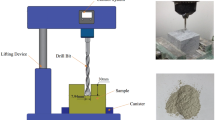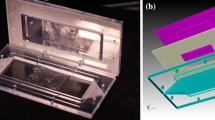Abstract
Comminution (fragmentation) of solid particles is important in a range of technologies. An interesting effect is the so-called comminution limit (CL), which is effectively a brittle/ductile transition. Above the CL particles fail by fracture. However, as particle size decreases the amount of stored energy in the particle also decreases and eventually there is no longer sufficient stored energy in the particle to propagate a crack and the particle flows plastically. The CL depends on the hardness, H, and the toughness, K Ic. In mountainous countries, two-reservoir systems are used to generate and store power. When power is needed, water runs through the turbines to the lower reservoir. If there is excess power, water is pumped to the upper reservoir. This recycling of liquid through the turbines can break up entrained particles. Previous work in this area has been primarily concerned with sedimentation of the particles. The research reported in this paper uses the CL to calculate the particle sizes produced for different materials including different rock types. Interestingly, the particle sizes predicted mainly fall in the range where they sediment near the upper water surface. In such cases, the surface layers become opaque to sunlight and plant and animal life will be affected. It is suggested that the CL provides additional information which would assist research in this area. Where H and K Ic are not known for a particular rock type they should be measured.
Similar content being viewed by others
References
Shishacov N (1938) Mosaic blocks of silicate glasses. Tech Phys USSR 5:666–675
Bonalumi M, Anselmetti FS, Kaegi R, Wuest A (2011) Particle dynamics in high-Alpine proglacial reservoirs modified by pumped-storage operation. Water Resour Res 47:W09523
Miracle RD, Gardner A (1980) Review of the literature on the effects of pumped storage operations on Ichthyofauna. In: Clugston JP (ed) Proceedings of the Clemson workshop on environmental impacts of pumped storage hydroelectric operations. US Fish and Wildlife Service, Washington DC, pp 40–53
Potter DU, Stevens MP, Meyer JL (1982) Changes in physical and chemical variables in a new reservoir due to pumped-storage operations. Water Resour Res 18:627–633
Bezinge A (1987) Glacial meltwater streams, hydrology and sediment transport: the case of the grande dixence hydroelectricity scheme. In: Gurnell AM, Clark MJ (eds) Glacio-fluvial sediment transfer: an alpine perspective. Wiley, Chichester, pp 473–498
Hofmann A, Dominik J (1995) Turbidity and mass concentration of suspended matter in lake water: a comparison of two calibration methods. Aquat Sci 57:54–69
Davies-Colley RJ, Smith DG (2001) Turbidity, suspended sediment, and water clarity: a review. J Amer Water Resour Assoc 37:1085–1101
Bunn SE, Arthington AH (2002) Basic principles and ecological consequences of altered flow regimes for aquatic biodiversity. Environ Manage 30:492–507
Bühler J, Siegenthaler C, Wüest A (2005) Turbidity currents in an Alpine pumped-storage reservoir. In: Lee JHW, Lam KH (eds) Environmental hydrology and sustainable water management. A.A Balkema, Rotterdam, pp 239–244
Finger D, Schmid M, Wüest A (2006) Effects of upstream hydropower operation on riverine particle transport and turbidity in downstream lakes. Water Resour Res 42:W08429
Anselmetti FS, Buhler R, Finger D, Girardclos S, Lancini A, Rellstab C, Sturm M (2007) Effects of Alpine hydropower dams on particle transport and lacustrine sedimentation. Aquat Sci 69:179–198
Chanudet V, Filella M (2007) The fate of inorganic colloidal particles in Lake Brienz. Aquat Sci 69:199–211
Jaun L, Finger D, Zeh M, Schurter M, Wüest A (2007) Effects of upstream hydropower operation and oligotrophication on the light regime of a turbid peri-alpine lake. Aquat Sci 69:212–226
Anderson MA (2010) Influence of pumped-storage hydroelectric plant operation on a shallow polymictic lake: predictions from 3-D hydrodynamic modeling. Lake Reserv Manag 26:1–13
Frank FC, Lawn BR (1967) On the theory of Hertzian fracture. Proc R Soc Lond A 299:291–306
Sargent GA, Chen Y-L, Conrad H (1989) Hertzian fracture of pyrex glass in impact loading. In: Ludema KC (ed) Wear of materials. American Society of Mechanical Engineers, New York, pp 339–347
Hobbs DW (1964) The tensile strength of rocks. Int J Rock Mech Min Sci 1:385–396
Rumpf H, Schönert K (1972) Die Brucherscheinungen in Kugeln bei elastischen sowie plastischen Verformungen durch Bruckbeanspruchung. Dechema Monograph 69:51–86
Kendall K (1978) Complexities of compression failure. Proc R Soc Lond A 361:245–263
Hopkinson B (1914) The effects of the detonation of gun-cotton. Trans North-East Coast Inst Eng Shipbuild 30:199–217
Bowden FP, Brunton JH (1961) The deformation of solids by liquid impact at supersonic speeds. Proc R Soc Lond A 263:433–450
Kolsky H, Rader D (1968) Stress waves and fracture. In: Liebowitz H (ed) Fracture, vol 1. Academic, New York, pp 533–569
Boddy RGHB (1943) Microscope observations of the crushing of coal. Nature 151:54
Parish BM (1967) Effect of rank and particle size on plastic behaviour of coal. Br J Appl Phys 18:233–240
Steier K, Schönert K (1972) Verformung und Bruchphänomene unter Druckbeanspruchung von sehr kleinen Körnen aus Kalkstein, Quarz und Polystyrol. Dechema Monograph 69:167–192
Puttick KE (1979) Energy scaling, size effects and ductile-brittle transitions in fracture. J Phys D Appl Phys 12:L19–L23
Kendall K (1978) The impossibility of comminuting small particles by compression. Nature 272:710–711
Karihaloo BL (1979) A note on complexities of compression failure. Proc R Soc Lond A 368:483–493
Hagan JT (1979) Micromechanics of crack nucleation during indentations. J Mater Sci 14:2975–2980
Hagan JT (1981) Impossibility of fragmenting small particles: brittle–ductile transition. J Mater Sci 16:2909–2911
Hird JR, Field JE (2004) Diamond polishing. Proc R Soc Lond A 460:3547–3568
Williamson DM, Proud WG (2011) The conch shell as a model for tougher composites. Int J Mater Eng Innov 2:149–164
Tabor D (1951) The hardness of metals. Clarendon Press, Oxford
Whitney DL, Broz M, Cook RF (2007) Hardness, toughness, and modulus of some common metamorphic minerals. Am Min 92:281–288
Zapryanov Z, Tabakova S (1999) Dynamics of bubbles, drops, and particles. Kluwer, Dordrecht
Acknowledgements
Professor J. E. Field thanks Dr M Farhat for the invitation to visit École Polytechnique Fédérale, Lausanne where this research was undertaken. Support from the Swiss National Science Foundation (Project 2100-063842.00-1) is acknowledged.
Author information
Authors and Affiliations
Corresponding author
Rights and permissions
About this article
Cite this article
Field, J.E., Farhat, M. & Walley, S.M. Comminution limit (CL) of particles and possible implications for pumped storage reservoirs. J Mater Sci 49, 3780–3784 (2014). https://doi.org/10.1007/s10853-014-8089-3
Received:
Accepted:
Published:
Issue Date:
DOI: https://doi.org/10.1007/s10853-014-8089-3




